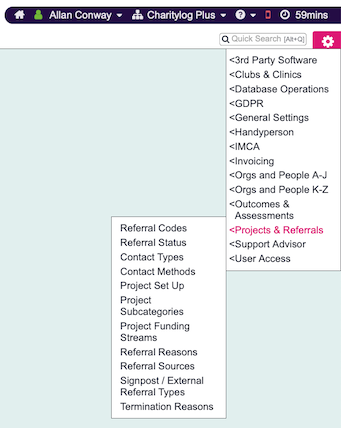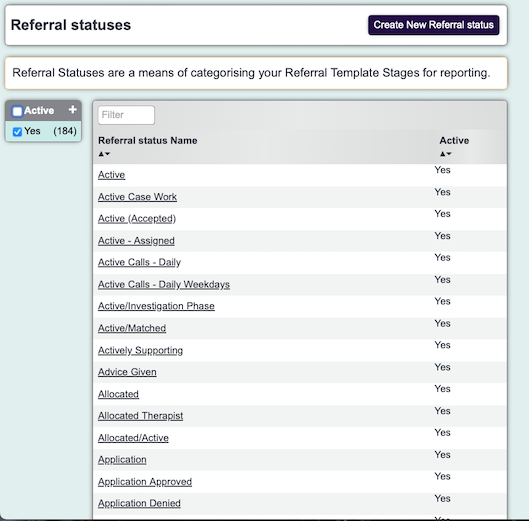Difference between revisions of "Referral status"
Alanconway (talk | contribs) |
Alanconway (talk | contribs) (→Setting up Referral Status) |
||
| Line 59: | Line 59: | ||
| − | You can then see all the available statuses which are based on all available Stages that are already in use. To add a new status, click on '''Create New Referral Status.''' Remember, you can create a single status that is used by multiple projects which may aid reporting. Once you have the statuses set, you can go [https://wiki.dizions.co.uk/index.php/Referral_Templates Referral Templates] to set the status against the rates. | + | You can then see all the available statuses which are based on all available Stages that are already in use. To add a new status, click on '''Create New Referral Status.''' Remember, you can create a single status that is used by multiple projects which may aid reporting. Once you have the statuses set, you can go [https://wiki.dizions.co.uk/index.php/Referral_Templates Referral Templates] to set the status against the rates. To avoid confusion, you may wish to deactivate statuses that will not be used. To do this, click on each one, then set ''Active'' to No. |
[[File:refstatuslist.png]] | [[File:refstatuslist.png]] | ||
| − | |||
=Adding Status to Referral Stage= | =Adding Status to Referral Stage= | ||
Revision as of 13:18, 28 February 2024
Introduction
PAGE UNDER CONSTRUCTION
Referral Status is used in conjunction with Referral Templates. It allows you to use multiple stages which can reflect the task, or progress of that referral, yet be collated into a single status. For example, a Casework project might have the following:
| Referral Stage | Referral Status |
|---|---|
| Referral Received | Pending |
| First Contact | Pending |
| Assessment Arranged | Pending |
| Assessment Complete | Open |
| Pending Allocation | Open |
| Allocated | Open |
| First Appointment Booked | Open |
| First Appointment Attended | Open |
In the above example, you can see the referral wasn't counted as "Open" until the assessment has been completed. Then, all subsequent tasks were done at the open status. When it comes to closing the referral, it could also look something like this:
| Referral Stage | Referral Status |
|---|---|
| Closed - Complete | Closed |
| Closed - No Answer | Closed |
| Closed - Client Declined | Closed |
| Closed - Client moved away | Closed |
You can see this provides several reasons why the referral is considered as closed, but is summarised as just a closed referral. When it comes to reporting on this, you can just find out how many referrals have the "Closed" status, but also delve into the granularity and find out why they are closed. Another useful thing about Referral Status is that you can use the same status across multiple projects. This means you can use the same "Open" status across all projects, then run a single report which will tell you how many "Open" referrals you have.
Setting up Referral Status
If you would like to produce a series of standard referral statuses that all projects use, go to:Admin, Project & Referrals, Referral Status.
You can then see all the available statuses which are based on all available Stages that are already in use. To add a new status, click on Create New Referral Status. Remember, you can create a single status that is used by multiple projects which may aid reporting. Once you have the statuses set, you can go Referral Templates to set the status against the rates. To avoid confusion, you may wish to deactivate statuses that will not be used. To do this, click on each one, then set Active to No.



